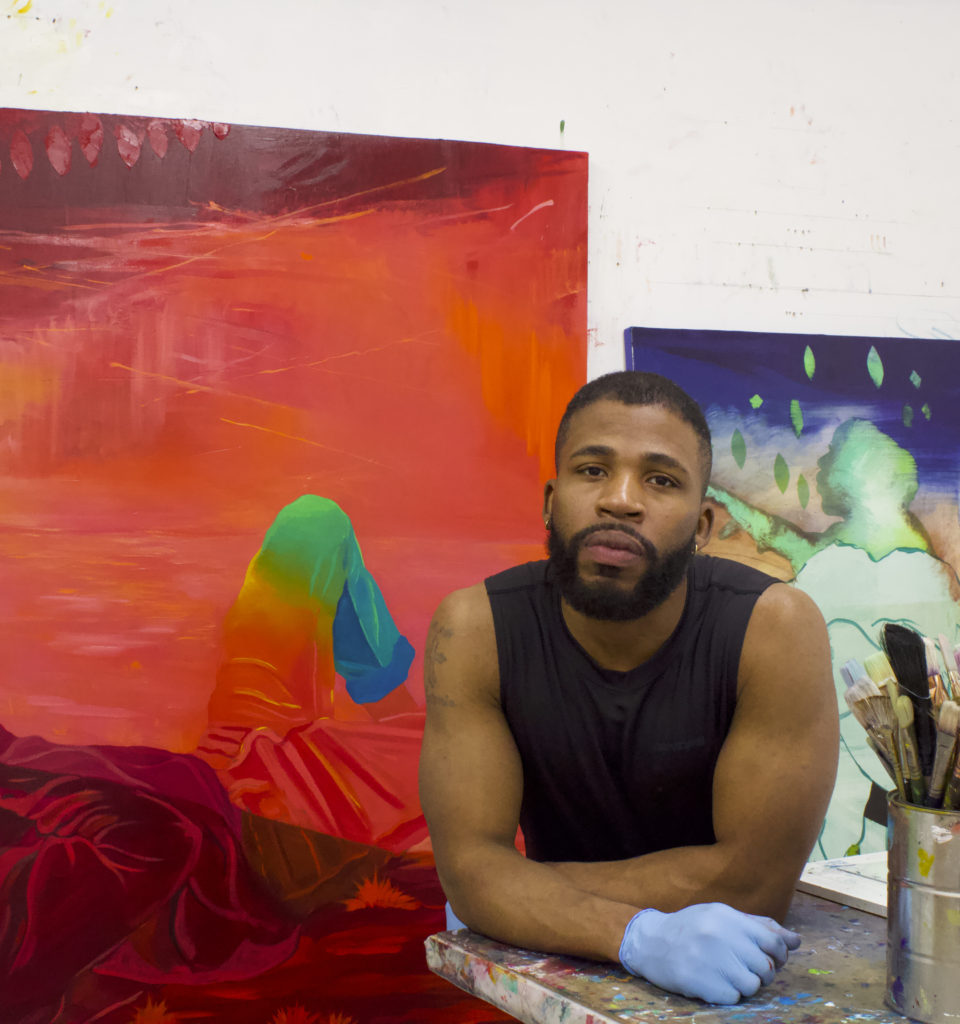
Dominic Chambers is a New Haven-based artist whose immersive, brightly-hued color field paintings explore Black intellectualism and moments of leisure. He earned a BFA from the Milwaukee School of Art and Design in 2016 and an MFA from Yale University in 2019, and has exhibited in shows across the US and Europe. In this interview, he shares his path to becoming an artist, how leisure became an essential theme in his work, his love of reading, and more. Find him on Instagram and on his website.
Aya Kusch: How did you discover your own creativity? What was your experience with art as a child, and what propelled you to pursue it as a serious career path as an adult?
Dominic Chambers: Like many young boys growing up in the late ’90s and the early 2000s, I fell in love with the classic animated television shows of that time; Dragon Ball Z, Yu-gi-oh, Pokemon, etc. I spent hours on end drawing and recreating characters similar to the characters I appreciated in those shows. Although, my family was quite poor and we never had white drawing paper casually laying around the house. To solve this problem I would tear the blank pages found in books between the cover and introduction. I never expected that the stories within those books would influence my work as an adult.
My introduction to the world of art was during my school trips to the St. Louis Art Museum. I always loved those field trips. The classrooms I went through during my childhood also had interesting pictures on the walls too. Outside of that, I didn’t grow up going to the art museum or galleries a lot. My family had other concerns to navigate. So I relied a lot on my imagination and the small amounts of knowledge I gathered from the art museum and various books I consumed. I remember being obsessed by Monet. I remember thinking to myself—Wow. These paintings remind me of spring.
As for pursuing art as a career, that’s a funny story because I didn’t know I wanted to be an artist. I didn’t even plan on going to college. But after a push from an ex-girlfriend, I decided to take some art classes at the Florissant Valley Community College in Ferguson. While I still hadn’t decided to pursue art as a career, I just knew that whatever I pursued, I wanted to be great at it. It wasn’t long before I learned of an artist named, Aaron Fowler. Aaron was a Black artist from a similar economic background as I did and he had gone to Yale to pursue his master’s in painting. From that moment, I knew that pursuing a life in the arts could be a possibility. I set forth and never looked back.
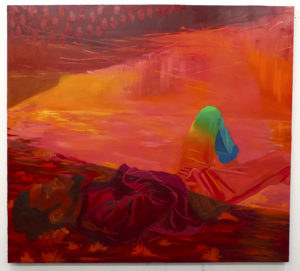
AK: How has your art evolved over time? What do you see as your biggest influences and/or formative experiences?
DC: I used to make monochromatic shaped paintings that responded to domestic architecture. Now my works are more figurative. Although, I do maintain an abstract painting investigation in my practice. Just not minimal anymore.
The most influential experience I had that really helped shape me as an artist was participating in the Yale Norfolk Summer Program. That was my first experience living day to day as an artist without any real academic coursework. From morning to night I could set my own pace and work as an artist. I had never had that before, but participating and having that experience really shaped the way I approach my studio practice today.
AK: How did you come up with the idea of depicting moments of leisure and contemplation? Why is this imagery important to show an audience?
DC: I think some ideas naturally unfold. During grad school I originally made one painting of a friend sitting in contemplation on a couch and the more time I spent with that painting, the more I felt like there was something more there to investigate. However, it may have come even earlier than that. My apple spirit drawings (the works I applied to Yale with) depicted young Black boys sitting in leisure within these imagined floral landscapes. For me, I felt this compulsion to resist showing the Black body, my body, in a moment, or performing an action that could draw historical associations I felt didn’t serve the conversation I wanted to have. Too often, the Black body has been located in our imaginations as one incapable of rest, and often when we imagine what the Black body is doing it is usually an act of labor, rebellion, or resistance. Instead, I was curious if I could remove the sensational or dramatic associations with the Black body, and present the Black subject within a painting on its own terms and still manage to discuss history, literature, and surrealism. It’s an interesting push and pull between how one constructs an image.
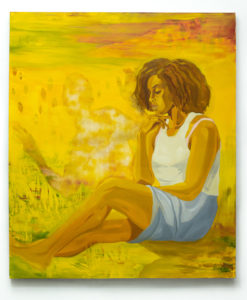
AK: Without naming names, who are the people you are portraying in your work? What makes them meaningful to you, and why have you chosen them for your art?
DC: The subjects in my paintings are all people that I have a personal connection with in some way. I think of my practice as a timeline of my life. In a way, the viewers of my work are growing with the subjects in my paintings. You may view a painting of a subject and they may have dreads. If you were to visit another painting a couple months later and the same subject could be used, only this time, they cut their hair. So in a way, you’re seeing these characters grow and change.
AK: What inspires you? Do you seek out inspiration, or is it more accidental?
DC: I would say, music and books are huge inspirations. I enjoy Thundercat and Parliament-Funkadelic, Coltrane, Soundgarden, Kid Cudi, and Rihanna, a lot. In addition to their musical talents, I enjoy their unique artistic perspectives. I love learning about where their music and art comes from. Even with writers—I loved learning about the influences that helped Marquez write 100 years of Solitude. Honestly, I think that’s what fuels me the most—listening to how people experience and view the world. I’m a junkie for artists’ lectures and books. For me, the ability to express the complexities of your experiences creatively is so exciting. I mean, I also get a lot of inspiration from slothing around in my living room too though. So I guess Inspiration can come from anywhere.
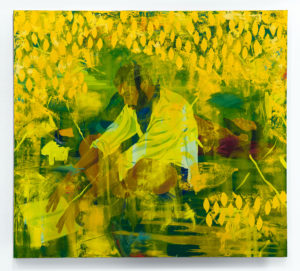
AK: What are your values in regards to your art? Are there any touchstone philosophies or intentions that you come back to?
DC: I believe that artworks are not simply nice things to look at. There is a respect that one must bring to the viewing experience of an art object. Otherwise, the artwork may not be fully appreciated for either its aesthetic or intellectual value. Always bring curiosity with you. A touchstone philosophy? Always show up. Nothing else can happen until you do that. Secondly, Make friends with failure. Become best friends with that shit. Lastly, If you’re going to do something, do it like you mean it and be great at it.
AK: Can you describe your process? What part of making art do you enjoy the most? What, if any, challenges emerge during your process, and how do you overcome them?
DC: My process isn’t very exciting, I draft out the painting and begin to build it up. I hope to display a kind of proficiency and competency with my medium when I work. Although, I try not to let that paralyze me. I never claim to be a great painter and I think that’s what I enjoy. The act of painting still feels so new to me. There’s so much I don’t completely understand and I think that keeps the process exciting.
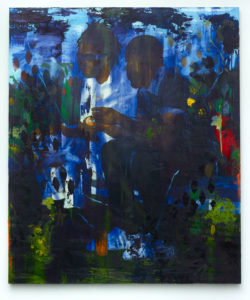
AK: What is the last artwork (or artist) you saw that moved you?
DC: Derrick Fordjours’s exhibition at Petzel Gallery was an outstanding exhibition. That exhibition left me so invigorated to get in the studio.
AK: What is your relationship like with books and reading? Are there any books or authors you would recommend?
DC: I was introduced to books early on. My sister, Deanna would take me to the library with her as a kid and I remember being so amazed at the space of the library. There were towers of bookshelves everywhere and on those bookshelves were numerous books! All different colors and with different fonts and titles. I loved going with her. Also, for a time, my family was homeless and spent some time in these parks in Downtown St. Louis. Interestingly enough, the park was directly across the street from the public library. Oddly enough, I think that libraries have always had some sort of close proximity to my life despite my personal circumstances.
Now, I’m a coffee and book addict. I actually have a hard time watching TV because of how predictable some of the plots are. However, with books, there’s always an exciting twist waiting for you. The characters are richer and I think I have a deeper appreciation for the use of language in written form. It’s impressive what some writers can do with words. The poet Jericho Brown is phenomenal with words. I’m currently reading a horror novel, which is unusual for me. It’s called A Head Full of Ghosts by Paul Tremblay. Authors I would recommend—Carlos Zafon, Jhumpa Lahiri, Junot Díaz, and Zadie Smith.

AK: What are you working on now?
DC: I’m working to make my work better.
AK: These are particularly difficult times, and everyone is learning how to adapt. How have you seen your own practice change, if at all? What advice would you give to an artist struggling to create?
DC: My practice hasn’t changed much at all. Although my physical and mental relationship to my studio has been affected. As someone who moves quickly and has a propensity to be a bit edgy, I want to be more deliberate and conscious about what it is that I’m feeling. I guess that moving with more intention has been something I’ve been trying to do more of.
As for advice to an artist struggling to create: Make something small. Be curious by what it is that you’ve made and see if there’s any place you could take that small idea so that it can grow.
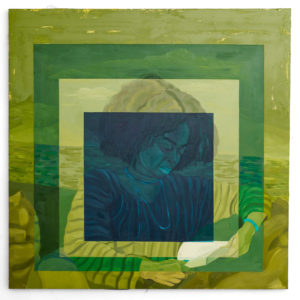
AYA KUSCH is an editor, artist, and freelancer based in San Francisco. She grew up playing with mud, which eventually led to a love of clay and a subsequent BFA in sculpture. She is fourth-generation Japanese and a third-generation potter, a Bay Area native, and a former bookseller who still obsesses over the best way to organize a bookshelf. She loves good design, contemporary art that will worry your mom and confuse your dad, and sculptures that make you look up. She is currently working on a book about art from Edo, Japan.
